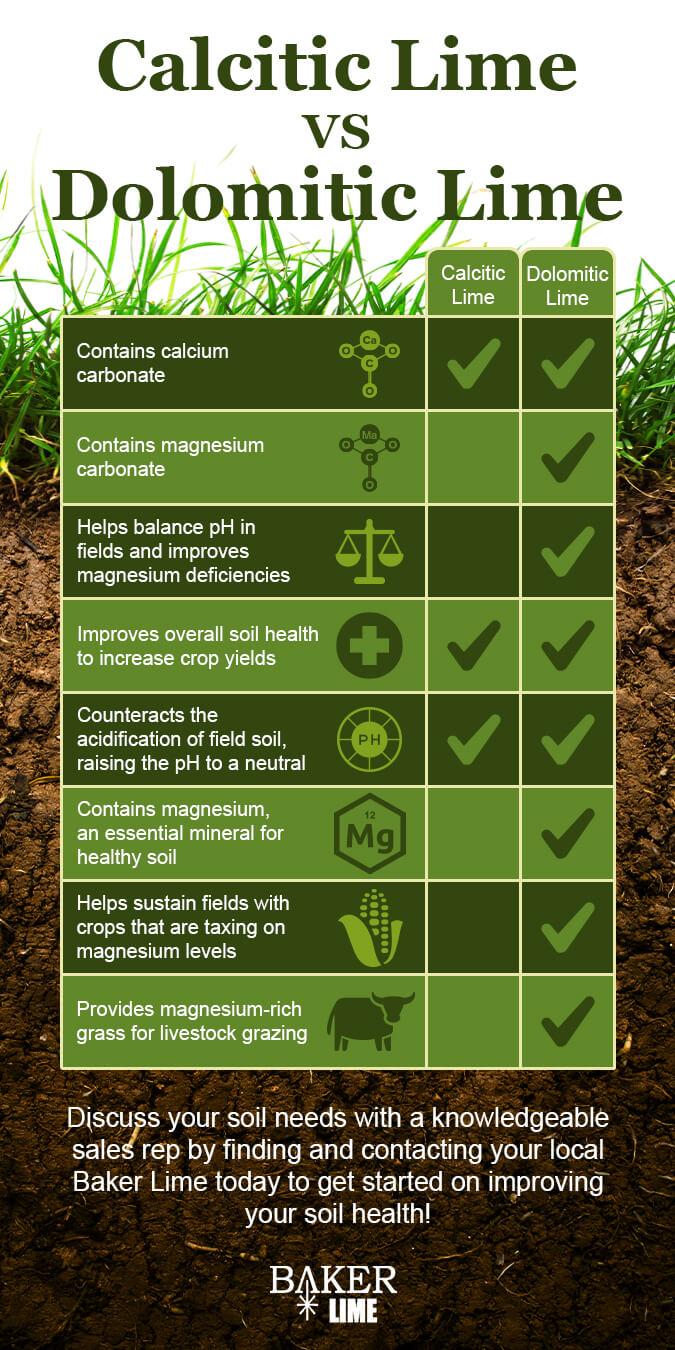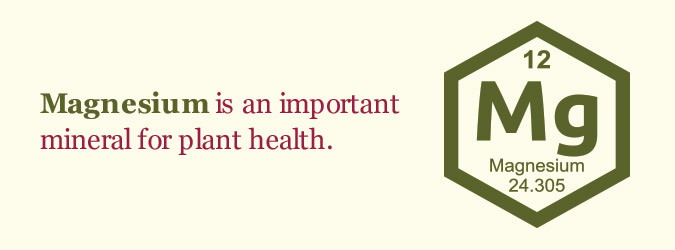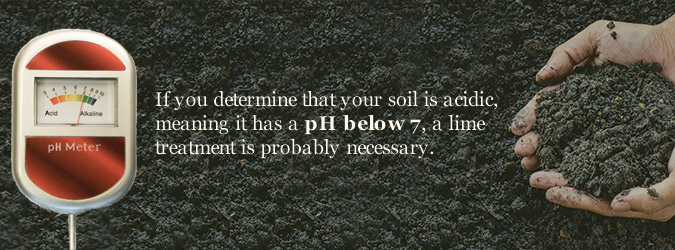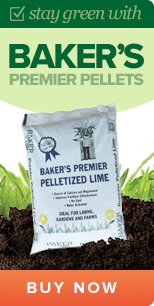Dolomitic Lime vs. Calcitic Lime for Lawns
Table of Contents
Author/Reviewed By: Josh Miller, Sales Manager: Baker Lime & North America Minerals
Published: 11/16/2015 – Updated: 8/23/2021
On the surface, Calcitic lime and dolomite lime seem like very similar products. They are both made from pulverized limestone, and both are effective at raising the pH in acidic soils. But what exactly is the difference between dolomitic and calcitic limestone?
These similar products actually have a strikingly different influence on your soil. The primary difference lies in the use of magnesium: Dolomite lime contains large amounts of magnesium along with calcium carbonate while calcitic lime only contains calcium carbonate.
Magnesium is an important mineral for plant health. And if soil needs magnesium, wouldn’t it be best to just use dolomite lime all the time, just in case? Not if too much magnesium can also be a problem. To keep a proper balance of magnesium in your soil, you need to be careful when selecting the proper lime for your fields.
To make choosing the best liming product a little easier, we’ve prepared a quick comparison of calcitic lime and dolomite lime. Learn more about the benefits and drawbacks of each type of lime application so you can make an informed decision. You can also find and contact your local Baker Lime dealer to speak with a sales representative who will answer your questions directly.
Request A Quote On Our Lime Options!
Dolomite vs Calcite: Determining What Your Soil Needs
Before you begin an in-depth exploration of which lime treatment option is best for you, you need to determine your soil needs.
First and foremost, you need to determine your soil pH. If you determine that your soil is acidic, meaning it has a pH below 7, a lime treatment is probably necessary to adjust the pH level. You can use a home testing kit or you can have a professional come and perform a test for you.
But you will also want to determine if your soil is lacking other essential minerals. And while you want to confirm your soil’s mineral content, the soil type can usually point you in the right direction. Clay and clay loam soil tends to retain magnesium well because it drains poorly. Loam soil also retains magnesium well, but under certain conditions, it can become magnesium depleted. Finally, sandy soil is much more prone to mineral loss because drainage can leach the soil.
Once you have gathered the necessary information, you can begin to explore how to make the necessary corrections. But it’s important to gather this information first, as the wrong product may be ineffective. More importantly, some products can do more harm than good, because oversaturating your soil with certain minerals can be toxic to crops.
Before you begin ordering products for your fields, make sure you are confident about what your fields need. A high concentration of dolomitic soil or vice versa can become a much bigger problem than merely a waste of money.
What You Need to Know About Calcitic Lime vs. Dolomitic Lime
Calcitic Lime
Calcitic lime for lawns has long been the preferred treatment for acidic soil. A thorough application of pulverized limestone tilled into the soil raises the pH to a neutral level, increasing crop yields and improving overall soil health.
The main “ingredient” in calcitic lime is calcium carbonate, which is why many people ask if calcium carbonate is the same as limestone. It counteracts the acidification of field soil. Acidification is the natural result of nitrogen heavy fertilizing practices. By adding a lime treatment, you can undo the damage caused by nitrogen treatments without counteracting the benefits.
What are The Benefits of Calcitic Lime?
In addition to neutralizing pH, calcitic lime also:
- Encourages microorganism growth: With the combination of helpful microorganisms that contribute to plant health and pH-balanced soil, plants and crops will thrive.
- Balances pH effectively: Although waiting for the treatment to become fully effective requires some patience, calcitic lime will likely be the only treatment you’ll need to balance the pH level if you plant your fields every year.
- Works more quickly than dolomite lime: Calcium carbonate is better at balancing pHs than magnesium carbonate, and calcitic lime contains much higher levels of calcium carbonate than dolomite lime.
What are Calcitic Lime’s Limitations?
Typical calcitic lime treatments require some patience. If you apply dry calcitic lime on a dry field, you will need to wait for rain for the treatment to work. Water is required for the chemical process to begin.
You must also till the soil immediately after the lime application. Lime sitting on the surface of your soil will not be nearly as effective as lime that is well mixed into the soil.
But the main drawback to calcitic lime is its simplicity. It is designed to neutralize pH and replace depleted calcium in the soil, and it won’t replace depleted magnesium. If your fields are producing magnesium deficient crops, you will find that calcitic lime treatments won’t improve your crop health.
However, these are special conditions. Most soils only need calcitic lime as their magnesium levels are already optimal. For most applications, calcitic lime is best. But you should always double-check the mineral content in your soil just to be sure.
Dolomitic Lime
What are the Benefits of Dolomite Lime for Lawns?
In addition to neutralizing your acidic soil, the benefits of dolomitic lime include the following:
- Rich source of magnesium: Fields that are home to crops taxing on potassium levels — such as corn fields — can benefit from magnesium treatments. If your field contains a calcium-to-magnesium ratio of 6:1 or greater, it is considered to be magnesium deficient, and you should strongly consider using dolomite lime to balance your minerals. Proper calcium-to-magnesium ratios are important for ensuring healthy growth.
- Improved drainage and aeration: Dolomitic lime helps improve your soil’s aeration and drainage abilities when incorporated deep into the soil or even on the top layer.
- Garden ecosystem biodiversity: Dolomite lime contributes to more biodiverse soil by introducing additional nutrients with magnesium and calcium. A diverse soil ecosystem can give you healthier plants due to a wider variety of life that creates organic matter — like bacteria and worms.
What Are Dolomitic Lime’s Limitations?
While dolomitic lime works well if you need to raise your soil’s and plants’ magnesium levels, too much magnesium can cause your soil to become overly compact, deterring crop growth while also making the soil more difficult to water efficiently. Your plants won’t get the amount of water they need to thrive if the soil is too compact to properly absorb it, which starves the roots. Magnesium can also fuel rampant weed growth, further impeding the growth of your crops as the weeds sap nutrients from the soil and nearby plants.
Your soil’s magnesium needs often correspond with your soil consistency. Magnesium deficiency is much more common in quick-draining soils, especially sandy varieties. In contrast, clay and clay loam soils rarely suffer from magnesium issues.
If your fields contain a large amount of clay soil, it is unlikely that you will want to use dolomite lime. In fact, because dolomite can make soil compaction worse, an ill-advised dolomite application can seriously harm denser clay soils.
Additionally, undoing a dolomite lime treatment can be tough. Sulfur and nitrogen treatments can bring your magnesium levels back into line, but these treatments are time-consuming and can be expensive.
Which Lime Treatment Is Better: Dolomitic Lime or Calcitic Lime?
Plus, if you don’t need dolomite lime to incorporate magnesium, calcitic lime works better at restoring pH. Even though magnesium carbonate is alkaline just like calcium carbonate, it doesn’t work quite as effectively. So if you are merely looking to correct the pH balance, you are much better served choosing calcitic lime.
With this in mind, you should only use dolomite lime if you need to add magnesium to your soil. The risks posed by introducing too much magnesium far outweigh any benefits. As always, if you are unsure about the nature of your soil, make sure to contact a professional to measure your soil pH and mineral content before ordering a lime treatment.

Dry vs. Damp Lime
When choosing a lime treatment, you will also have to choose whether to use damp lime or traditional dry lime. Both liming products have their advantages and disadvantages.
Damp lime reacts more quickly, since water reacts with lime to neutralize the pH. It is also easier to apply damp lime uniformly throughout your fields. However, it is also more labor intensive to apply and in the end, you will likely need more of it.
Dry lime is more efficient and more affordable. It works better with most agricultural equipment and is easier to transport. If you are looking to complete a large agricultural application, dry lime will likely make more financial sense.
With a good dry lime application, you can balance your pH without repeat applications, but the results may not be noticeable for up to a year.
So if you are looking for a quick pH rebalance, you should consider damp lime: If you want to see immediate results, perhaps because you are renting your fields, and are less concerned about long-term results, damp lime could be the best solution.
However, if you have a large field and the means to apply one thorough lime treatment every year, dry lime will be better for you in the long run. The higher concentration of lime means the soil will be more completely treated, even if it does take a little bit longer to take effect.
For most full-time agriculturalists, dry lime is the best choice.
Fine Pulverized vs. Pelletized Lime
In addition to choosing between dry and damp lime, you can also choose between pulverized dolomitic limestone and pelletized lime. Each have their applications, so depending on your needs, you will find either one or the other better suited for your use.
Pelletized lime is especially good for garden use. It is easier to spread if you do not have large scale agricultural equipment. Pelletized lime also tends to react more quickly, as it more thoroughly processed before it is pelletized.
Pelletized lime is less subject to windy and dry conditions: Pulverized lime is best applied during moist weather, as wind and dry conditions can cause the lime application to blow around and become less evenly applied.
However, because pelletized lime is more processed, it also tends to be more expensive by weight. If you are distributing a small amount of lime, such as in a small garden, the difference in price should not be noticeable. However, if you are distributing a large quantity of lime across an entire field, pelletized lime’s added price can become quite prohibitive.
Need Help Choosing The Best Liming Products?
Deciding whether calcitic lime or dolomite lime is best for you can be difficult. If you are having trouble deciding, you can contact a Baker Lime representative to discuss your options. Our professional and friendly consultants have years of experience helping farmers and gardeners till healthier and more productive soil.
And if you already know which type of lime you need for your fields, find and contact one of our reps today to place an order.
Regardless of which kind of lime you need in order to improve the pH level in your fields, Baker Lime has the product you need. Because both calcitic lime and dolomite lime can drastically change the mineral make-up of your fields, you want to be sure that you are getting the product that is best suited for your needs.
Calcitic lime is the standard treatment. It balances pH efficiently while also encouraging the growth of plant-healthy micro-organisms. But if your fields are also magnesium deficient, which is especially common in sandier soils, only dolomite lime will raise the magnesium levels. This is especially important if your fields are used for livestock grazing, as magnesium deficiency can negatively affect your herd.
Finally, you’ll need to decide if you need damp or dry lime and whether to use pulverized or pelletized lime. If you have a larger field, dry, pulverized lime will probably be the most cost efficient. However, if you do need to quickly correct an extreme acidity in your soil, then damp lime may be best. Additionally, if you have a small garden without large agricultural equipment, you should consider pelletized lime, as it is easier to apply by hand.
Once you’ve determined the best product for your needs, or if you need to discuss your needs further with a knowledgeable sales rep, find and contact your local Baker Lime and get started on improving your soil health!











